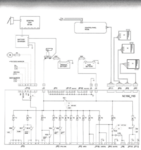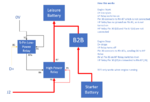xsilvergs
Free Member
- Messages
- 240
Today I called into Sterling Power in Droitwich, I was passing, and looked at their BB1260, a 12 volt 60 amp battery to battery charger.
Why? Our 2017 Fiat's alternator puts out quite low voltages and hence struggles to charge the Service Battery, a Varta LA95 AGM battery, quick enough. See image for voltage, current and SOC on today's drive on motorways and A roads.
The best way to connect the B2B's I think is:- B2B input to Car Battery - B2B output to Service Battery. The only trouble is the Car and Service batteries will get connected by a parallel path when the split charge relay in the Nordelettronica NE196-T controller is energised when the engine is running. I have used the terms Car and Service for the batteries as per the circuit diagram.
I have looked around the www for ideas to stop this parallel path:-
One idea is to disconnect the Service battery from the J2 terminal using a relay whilst it is being charged by the B2B.
Second idea is to put a 100 amp diode between the Car Battery and J1 terminal.
I do have my own idea which is more complicated (i was an electronics technician in my working life) but I thought I would ask others their views.


Why? Our 2017 Fiat's alternator puts out quite low voltages and hence struggles to charge the Service Battery, a Varta LA95 AGM battery, quick enough. See image for voltage, current and SOC on today's drive on motorways and A roads.
The best way to connect the B2B's I think is:- B2B input to Car Battery - B2B output to Service Battery. The only trouble is the Car and Service batteries will get connected by a parallel path when the split charge relay in the Nordelettronica NE196-T controller is energised when the engine is running. I have used the terms Car and Service for the batteries as per the circuit diagram.
I have looked around the www for ideas to stop this parallel path:-
One idea is to disconnect the Service battery from the J2 terminal using a relay whilst it is being charged by the B2B.
Second idea is to put a 100 amp diode between the Car Battery and J1 terminal.
I do have my own idea which is more complicated (i was an electronics technician in my working life) but I thought I would ask others their views.



